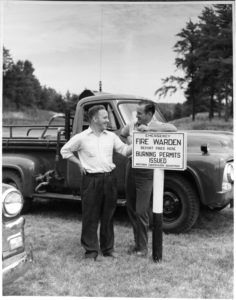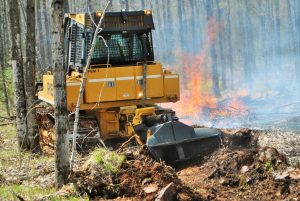by: Catherine Koele, DNR wildfire prevention specialist
Rooted deep in Wisconsin’s forest fire control history, the Emergency Fire Warden (EFW) program is a long-standing partnership that has benefitted the State of Wisconsin since the turn of the century. While the role and number of EFWs has changed significantly over time, evolving from detection and suppression duties to the current role of mainly issuing burning permits, a few of those iconic ‘fire warden’ signs continue to hang on fence posts in small, rural communities throughout Wisconsin.

Historically, emergency fire wardens played an important role in preventing, detecting and suppressing wildfires. Photo taken in 1955 near Park Falls, WI.
Since 1885, Wisconsin’s emergency fire wardens have been on the front line of forest fire control, promoting fire prevention and helping to fight fires. Fire wardens were expected to post fire warnings, prohibit burning during dry months and report on fires. Fire wardens were often the first to report forest fires to the local fire departments and ranger stations. They also organized, hired and served on fire-fighting crews.
Men and women from all walks of life volunteered to become emergency fire wardens; farmers, shopkeepers, mechanics, teachers, tavern owners, loggers, paper mill employees, retired couples and many others. In addition to fighting fires, they were asked to issue burning permits and keep track of who was burning and where, in case a fire was to get out of control. Continue reading “The honored role of the emergency fire warden, yesterday and today”

 Wisconsin has already had more than 200 wildfires in 2017 since the snow-cover disappeared with the potential of more before vegetation greens up and the fire danger subsides.
Wisconsin has already had more than 200 wildfires in 2017 since the snow-cover disappeared with the potential of more before vegetation greens up and the fire danger subsides.